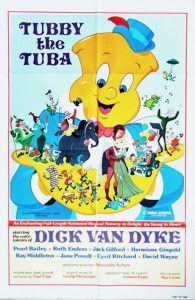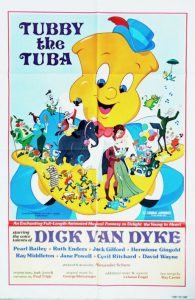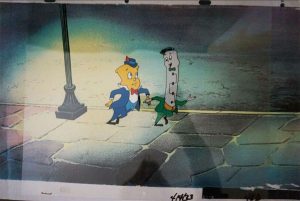
 Some films have behind-the-scenes stories that are more compelling than the film itself. Tubby the Tuba is one of them.
Some films have behind-the-scenes stories that are more compelling than the film itself. Tubby the Tuba is one of them.
What began as a children’s record album three decades before its release turned into a production that would involve a University in New York, a former children’s TV show host, veterans of the animation industry, a voice cast of well-known actors and comedians, and the future founders of Pixar in a serpentine path that led to the film’s production.
In 1945 songwriter Paul Tripp and composer George Kleinsinger released a children’s record album entitled Tubby the Tuba, narrated by Danny Kaye. It tells the tale of the title character, who is sad that he doesn’t get more to do in the orchestra than play “oom-pah” and wants a melody all his own. For more on the extensive history of the song, see Greg Ehrbar’s 2021 article.
In addition to his skills as a songwriter of Tubby the Tuba, Tripp was also an actor who appeared in a number of TV shows, including The Twilight Zone and The Dick Van Dyke Show. He’s probably most well-known to an entire generation as the host of the popular children’s show Mr. I. Magination, which aired from 1949 to 1952.
The animated possibilities of Tubby the Tuba were first realized by filmmaker George Pal, who adapted the story in his 1947 stop-motion Puppetoons short subject, which was well-received and went on to receive an Academy Award nomination.
It would then be two and a half decades later before Tubby the Tuba came to life again in animation. In the early seventies, Alexander Schure, founder of the New York Institute of Technology (NYIT) in Westbury, New York, announced a feature-length adaptation of Tubby the Tuba.
The film’s production would be done at the University’s animation department on the campus. However, as work on Tubby the Tuba progressed, there was a need to bring in more seasoned animators and filmmakers.
Schure brought in animator and producer Sam Singer, best known for his TV show Courageous Cat and Minute Mouse, as well as a number of veteran New York animators, including John Gentilella and Jack Dazzo, who worked on classic Popeye cartoons.
As production of an animated feature can take some time, Schure also looked to speed up the process by turning to a field still in its infant stages: computer animation. A number of scientists working at NYIT in the emerging realm of computer graphics were brought in as consultants. Two of them were Ed Catmull and Alvy Ray Smith, who would go on to be two of the founders of Pixar.
 Tubby the Tuba could have been the first film to use computer-generated imagery, but ultimately, no computer animation wound up being used in the film, and it was completed using traditional animation. The studio Avco Embassy acquired the rights to Tubby the Tuba, releasing it to theaters fifty years ago this month on April 1, 1975.
Tubby the Tuba could have been the first film to use computer-generated imagery, but ultimately, no computer animation wound up being used in the film, and it was completed using traditional animation. The studio Avco Embassy acquired the rights to Tubby the Tuba, releasing it to theaters fifty years ago this month on April 1, 1975.
Tubby the Tuba opens with an orchestra in a symphony hall tuning up, but as the camera gets closer, we see that this orchestra is comprised of anthropomorphic instruments. As the conductor is about to begin, Tubby the Tuba becomes disappointed that all of the other instruments have such nice melodies to play while he has nothing but the same “oom-pah” notes again.
Laughed at by the other instruments, a despondent yet determined Tubby sets off to find a melody to play on an adventure that leads to fame and fortune as he learns a lesson about being true to who he is.
Tubby the Tuba boasts an impressive voice cast, including Dick Van Dyke as Tubby, Pearl Bailey as Mrs. Elephant who he meets when he decides to join the circus, Jack Gilford as The Herald of Singing City, which Tubby visits, David Wayne as Tubby’s best friend, Pee-Wee the Piccolo, Jane Powell as Celeste, the orphaned melody, Hermione Gingold as Miss Squeek, the leader of the orphaned tunes, Cyril Ritchard as Mr. Frog, who befriends Tubby and Paul Tripp as the Narrator.
Broadway veteran Lehman Engel crafted songs in the film.
Even with all of this talent, the result of 1975’s Tubby the Tuba is best summed up by Jerry Beck in his book, The Animated Movie Guide, as he writes, “Visually the film is a mess – but a relatively pleasant one.”
It may not have hit any high notes at the box office or in animation history, but fifty years later, Tubby the Tuba still provides a compelling behind-the-scenes story.








